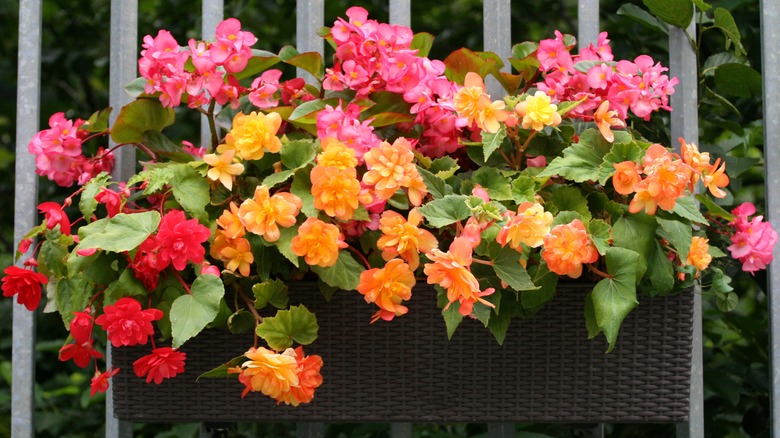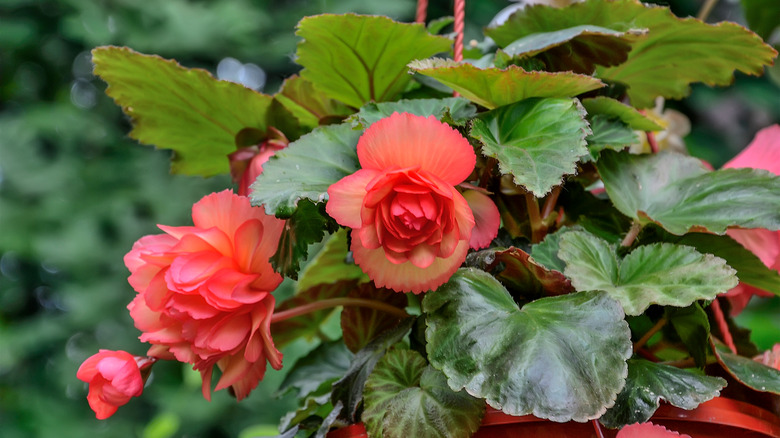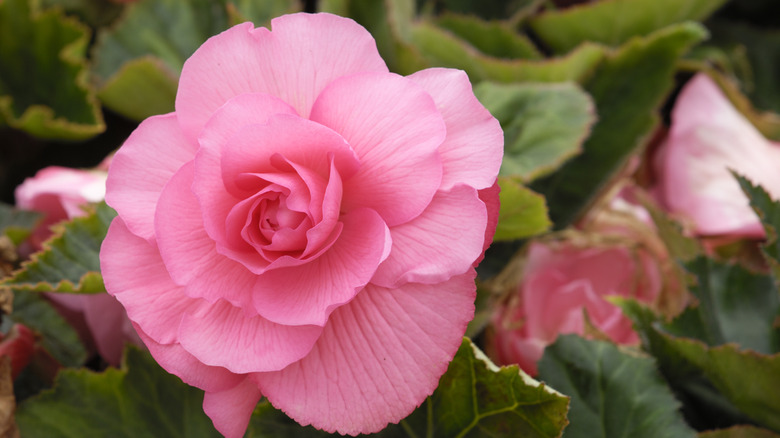The Best Spot In Your Garden To Plant Begonias
Begonias are a commonly found houseplant, but they can also thrive directly outdoors in your garden if given the proper conditions, just like hydrangeas. With more than 10,000 known varieties — including hybrids — begonias are the perfect touch for your outdoor spaces, never falling short of different flowers and foliage to choose from. Some begonias will bloom from spring and throughout winter; others will be your typical annuals and perennials that fall back as autumn approaches.
There are three primary groupings of begonias based on their root systems: Fibrous-rooted, rhizomatous, and tuberous-rooted. While each category will have slightly different specialized care to get the most successful growth, overall, begonias will prefer shaded locations that allow them to remain moist — but not too wet. Begonias can be a sensitive plant variety, as few can handle full sunlight the way our roses and zinnias do. However, their ruffled and layered flowers, striking greenery, and diverse shapes and sizes make them more than worth the effort.
The best spot to plant begonias
Begonias are tropical and subtropical plants, growing in hardiness zones that vary between 8 and 12. Naturally, you'll find few begonia species that don't prefer a minimum of partial shade and aerated, moist soil. Tuberous-rooted are more tender in direct sunlight than other root systems and don't do well when exposed to excessive heat. This category of begonia should be given bright (but not too bright) light and planted in shaded areas that won't receive more than four hours of full sunlight on a given day. This species doesn't go dormant in colder months and makes an excellent flower for your garden's bed.
Fibrous begonias are usually grown annually and flourish in hanging baskets and other containers. They bloom from spring to fall and shouldn't be given more than partial sun throughout the day. They grow better in cooler areas but withstand more sunshine than the other two groupings. If you want to keep your fibrous growing after the first frost, they can be taken indoors until warm weather returns. Rhizomatous grow most successfully in indirect sunlight and slightly shaded areas, but the bright morning sun won't necessarily hinder it. This category is known more for its enticing and dramatic foilage, but will still bloom in the right climates. Generally, your garden begonias will prosper if planted on your yard's north and east side or in shaded spots against porches and patios.
Begonias to grow in your garden
With so many varieties of begonias, it can take time to narrow down your options and choose the perfect ones for your garden. House Digest has you covered with recommendations that will thrive and sprinkle your garden with a one-of-a-kind look. In the fibrous category, the charm and wax begonia are beautiful additions. Charm features pink florals with bright green leaves that often speckle with a yellowish hue as it matures. You can expect it to grow 10 to 15 inches in height, and they're a great fit for your hanging baskets. Conversely, Wax is slightly smaller at 6 to 12 inches tall with tiny but vibrant flowers that pair with crimson foliage. Wax begonias are also known to be more resilient than others.
The tuberous dusty rose and Mocca yellow begonia grow approximately a foot tall and wide. Dusty rose sports vivid pink, rose-like flowers, also loved for its easy-to-grow qualities. The Mocca yellow will brighten up your shaded locations and compensate for the lack of sunshine begonias require. Its layered yellow petals greatly contrast its deep, purplish leaves. The rex begonia is a rhizomatous class with countless colors and patterns that overtake its greenery. A mature rex will boast leaves 5 to 9 inches wide and grow to be 12 to 18 inches in total size. Rhizomatous begonias are exciting to feature in your garden as their star-shaped and uniquely-cut leaves bring dimension that many other plants don't.



